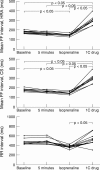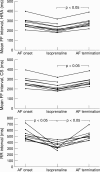Electrophysiological effects of flecainide and propafenone on atrial fibrillation cycle and relation with arrhythmia termination
- PMID: 10409531
- PMCID: PMC1729125
- DOI: 10.1136/hrt.82.2.176
Electrophysiological effects of flecainide and propafenone on atrial fibrillation cycle and relation with arrhythmia termination
Abstract
Objectives: (1) To investigate the electrophysiological effects of flecainide and propafenone during atrial fibrillation, and their relation to arrhythmia termination; (2) to investigate the effects of isoprenaline on atrial fibrillation in basal conditions and during treatment with class 1C drugs to evaluate the role of adrenergic stimulation on proarrhythmic events occurring during this treatment.
Design: Prospective, single centre study.
Setting: University hospital.
Methods: 10 patients with lone paroxysmal atrial fibrillation underwent an electrophysiological study. The dynamic behaviour of MFF (the mean of 100 consecutive atrial fibrillation intervals) was evaluated at two atrial sites after induction of atrial fibrillation either at baseline or after class 1C drug administration (flecainide or propafenone 2 mg/kg). The effects of isoprenaline on MFF and RR interval were also investigated both under basal conditions and during class 1C drug treatment.
Results: After induction of atrial fibrillation, mean (SD) MFF shortened with time, and was further shortened by isoprenaline infusion (177 (22) v 162 (16) v 144 (11) ms, p < 0.05). The administration of class 1C drugs reversed this trend and significantly increased the MFF to an average of 295 (49) ms, leading to conversion to sinus rhythm within 10 minutes in all patients. Atrial fibrillation was then reinduced on class 1C drugs: isoprenaline shortened the MFF and RR interval with a trend to AV synchronisation (223 (43) v 269 (49) ms for the MFF, 347 (55) v 509 (92) ms for the RR, p < 0.05); 1:1 sustained AV conduction occurred in two patients, at 187 and 222 beats/min respectively. One of these patients underwent electrical cardioversion because of haemodynamic collapse.
Conclusions: Class 1C drugs are effective at restoring sinus rhythm by increasing the MFF to a much greater extent than observed in self terminating atrial fibrillation episodes, and reversing the spontaneous atrial fibrillation behaviour (progressive shortening of MFF and self perpetuation of atrial fibrillation). MFF prolongation with 1:1 conduction at fast ventricular rates may lead to synchronisation during adrenergic stimulation, with a very short ventricular cycle; hence it is advisable to keep the patients at rest after acute class 1C drug loading or to consider pharmacological modulation of AV conduction for patients who are prone to a fast ventricular response.
Figures



Similar articles
-
Regular ventricular rhythms before conversion of recent onset atrial fibrillation to sinus rhythm.Pacing Clin Electrophysiol. 1994 Nov;17(11 Pt 2):2114-7. doi: 10.1111/j.1540-8159.1994.tb03810.x. Pacing Clin Electrophysiol. 1994. PMID: 7845827 Clinical Trial.
-
The value of class IC antiarrhythmic drugs for acute conversion of paroxysmal atrial fibrillation or flutter to sinus rhythm.J Am Coll Cardiol. 1990 Dec;16(7):1722-7. doi: 10.1016/0735-1097(90)90326-k. J Am Coll Cardiol. 1990. PMID: 2123909 Clinical Trial.
-
Oral antiarrhythmic drugs in converting recent onset atrial fibrillation.Pharm World Sci. 2004 Apr;26(2):66-78. doi: 10.1023/b:phar.0000018593.02291.c0. Pharm World Sci. 2004. PMID: 15085940 Review.
-
Outpatient treatment of recent-onset atrial fibrillation with the "pill-in-the-pocket" approach.N Engl J Med. 2004 Dec 2;351(23):2384-91. doi: 10.1056/NEJMoa041233. N Engl J Med. 2004. PMID: 15575054 Clinical Trial.
-
[Therapy of atrial fibrillation with class III anti-arrhythmia agents].Herz. 1993 Feb;18(1):20-6. Herz. 1993. PMID: 8454249 Review. German.
Cited by
-
Reconceptualising Atrial Fibrillation Using Renewal Theory: A Novel Approach to the Assessment of Atrial Fibrillation Dynamics.Arrhythm Electrophysiol Rev. 2021 Jul;10(2):77-84. doi: 10.15420/aer.2020.42. Arrhythm Electrophysiol Rev. 2021. PMID: 34401179 Free PMC article. Review.
-
[Pharmacological cardioversion of atrial fibrillation].Z Kardiol. 2005 Jan;94(1):14-22. doi: 10.1007/s00392-005-0166-9. Z Kardiol. 2005. PMID: 15668825 Review. German.
-
Time-dependent antiarrhythmic effects of flecainide on induced atrial fibrillation in horses.J Vet Intern Med. 2018 Sep;32(5):1708-1717. doi: 10.1111/jvim.15287. Epub 2018 Aug 22. J Vet Intern Med. 2018. PMID: 30133839 Free PMC article.
-
Mechanisms of termination and prevention of atrial fibrillation by drug therapy.Pharmacol Ther. 2011 Aug;131(2):221-41. doi: 10.1016/j.pharmthera.2011.02.002. Epub 2011 Feb 18. Pharmacol Ther. 2011. PMID: 21334377 Free PMC article. Review.
-
Prophylaxis and management of postoperative atrial fibrillation.Curr Cardiol Rep. 2005 Sep;7(5):382-90. doi: 10.1007/s11886-005-0093-4. Curr Cardiol Rep. 2005. PMID: 16105495 Review.
References
MeSH terms
Substances
LinkOut - more resources
Full Text Sources
Medical
